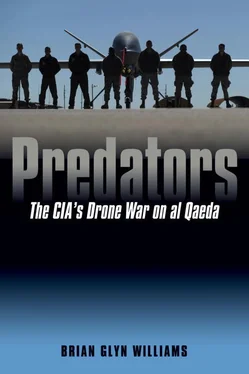But a group of several hundred Arab al Qaeda fighters and Taliban members decided to resist the Americans from a remote Afghan mountain enclave near the Pakistani border at a place called Shah i Kot. In March 2002 the United States launched Operation Anaconda, an airborne assault to try flushing out the enemy in this area. The Americans who landed in Chinook helicopters were ambushed soon after arriving in the mountains and began to take casualties. One U.S. helicopter was downed, and its crew fought to survive the withering fire from the ambushers who were shooting at them from a nearby bunker. In desperation the U.S. troops called for air support to suppress enemy machine-gun fire coming from a ridge known as Takur Ghar. U.S. F-15s and F-16s were sent to save the team, and they attempted to take out the enemy bunker using cannon fire and bombs. But the supersonic jets that were screeching overhead at almost six hundred miles per hour could not be “walked to the target” via radio by the encircled team on the ground. The F-15s almost bombed the entrapped Americans by accident, and so their runs were called off for fear of killing their own men with clumsy five-hundred-pound bombs.
At this time a CIA Predator drone was hurriedly sent to the scene. The drone’s cameras captured the scene below and relayed it back to CIA Headquarters in Langley. Using real-time high-resolution optics, the CIA operators were able to make out the Taliban bunker that had the American soldiers pinned down and to fire Hellfire missiles at it. When the bomb smoke cleared, a jubilant voice came from the trapped Americans on the ground: the enemy bunker had been destroyed. 27
By now both the Pentagon and Langley had come to see the value of the Predator drone as both a battlefield weapon and a tool for targeted assassination. The combat career of the remote-controlled UAV had begun. But at roughly this time a CIA drone may have also made its first confirmed kill of an innocent victim, showing that the drones could be double-edged swords. Just prior to Operation Anaconda, a CIA drone had spotted three men walking in the hills of Zawhar Kili. Zawhar Kili, which is in the Afghan east, had been used in the 1980s as a base by the mujahideen, including bin Laden at one time. It had been heavily bombed by the United States during Operation Enduring Freedom.
In February the CIA drone operators noticed that the three men in the hills near Zawhar Kili appeared to be led by a tall man. The decision was made to fire a missile on the men gathered on the hill in the hopes that the tall man was bin Laden. The missiles were fired, and three men were killed instantaneously without ever knowing what happened to them. It was later announced that the CIA had fired on a figure suspected to be bin Laden himself. But when a Washington Post war correspondent rushed to the remote scene of the attack to investigate, he found that the man on the hill was not bin Laden at all. In fact he was a local villager named Mir Ahmad. He and his friends were scavenging for scrap metal from U.S. ordnance on the Afghan-Pakistani border when the drone found and killed them. The reporter described his findings as follows:
“I was going past there toward Khost, and I heard the sound of an explosion,” [a local villager] said. “The three were cut in half. They were just poor people trying to get money to feed their families.”
Khan said Ahmad had two wives and five children. The Pentagon has said that an unmanned Predator drone spotted a group of men at Zhawar, and that others seemed to be acting in a deferential manner toward one tall man. U.S. officials have said they received other, unspecified information that the men were al Qaeda leaders before giving approval to fire the missile. 28
Another report from the area provides a heartbreaking account of how the local villagers dealt with the tragedy that had been inflicted on them by one CIA drone:
They were there making a living, Gir’s uncle said. His nephew “came down with a load of firewood from the mountains, and then said he was going out to collect some metal,” Janat Khan said. “He said he’d be back soon.”
Late that afternoon, they heard the news of the missile attack, Janat Khan said. The men of the village gathered coffins and went to retrieve the bodies.
“We were scared we would be bombed, but we had an obligation to bury them,” Qosmat Khan said. They had to collect the pieces of two of the men. Daraz’s body was intact, and he might have lived for a while, but he was dead when the village men arrived, said his brother. 29
When subsequently asked about the unfortunate incident by a reporter who wondered if the errant strike presaged “some kind of public relations disaster,” a defensive Donald Rumsfeld said, “I’m always concerned when there is an allegation made that suggests that some innocent person was—that an attack was inappropriate or that some innocent person was killed or injured. Obviously, anyone would be concerned about that.” 30Clearly everyone involved, from the secretary of defense to the head of the CIA, understood from this incident that the drones, for all their advanced optics and loitering capacity, were only as good as their intelligence. In their eagerness to kill bin Laden, the CIA drone operators had just killed three civilians in precisely the sort of mistake CIA director George Tenet had fretted about.
Thus, at a relatively early stage of the game, the CIA came to see the drones as an advantage and a liability. They were an unprecedentedly accurate tool for killing the likes of al Qaeda number three Muhammad Atef “al Kumandan,” but they were still reliant on solid humint in order to be effective. The local Afghan governor at Zawhar Kili captured this dichotomy when he said, “We are happy that they [the Americans] came, and we are ready to help them. But the people are starting to get angry at them.” 31
As the ongoing war against al Qaeda and its Taliban allies gradually shifted across the border from eastern Afghanistan to the Pashtun tribal zones in neighboring Pakistan, the Americans would continue to wrestle with a paradox. While the war against the Taliban was transformed into a hunt for HVTs, it became obvious that America’s most advanced weapon in the hunt for elusive terrorists might also be their worst enemy in the underlying battle to win the hearts and minds of the people of this volatile region.
It’s a new kind of war. We’re fighting on a lot of different fronts.
—U.S. secretary of state Condoleezza Rice
We cannot succeed in Afghanistan without shutting down those safe havens.
—Adm. Mike Mullen, the chair of the Joint Chiefs of Staff referring to the Taliban and al Qaeda’s sanctuary in the FATA
By the spring of 2002 the Pentagon believed that the majority of hardcore Taliban members had been driven from Afghanistan. Those few Taliban members who were still sniping at U.S. troops in Afghanistan were described by Secretary of Defense Donald Rumsfeld as “dead enders.” 1Operation Enduring Freedom had been one of the most effective invasions in the history of the Afghan “Graveyard of Empires.” It was now time to fill the void left by the collapse of the highly unpopular Taliban regime and rebuild the war-torn country that the United States had previously abandoned after the Soviets withdrew in 1989. The vast majority of Afghans wanted a return to school for their sons and daughters, new roads, demined fields, democracy, jobs, security, and an end to the Taliban’s harsh misrule. To prevent the Taliban from coming back, the Americans and their NATO allies would have to rebuild the devastated nation from the ground up and offer this long-suffering people hope.
Unfortunately, the United States did not initially invest in Afghanistan’s security and future because the Bush White House was adamantly opposed on principle to the notion of nation building. Candidate George Bush famously summed up his views on this topic when he stated, “If we don’t stop extending our troops all around the world in nation-building missions, then we’re going to have a serious problem coming down the road. And I’m going to prevent that.” 2For this reason the United States limited its military presence in the Texas-sized country of Afghanistan to less than ten thousand troops for the first few years of the conflict. The lack of a U.S. ground force allowed the down-but-not-out Taliban to begin to regroup in the Pashtun south as they awaited orders from their Pakistan-based leadership in the FATA and Baluchistan.
Читать дальше












